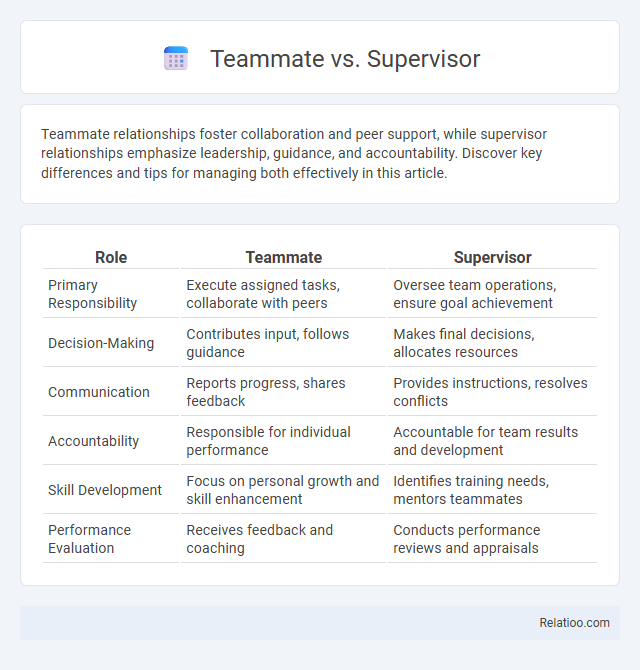Teammate relationships foster collaboration and peer support, while supervisor relationships emphasize leadership, guidance, and accountability. Discover key differences and tips for managing both effectively in this article.
Table of Comparison
| Role | Teammate | Supervisor |
|---|---|---|
| Primary Responsibility | Execute assigned tasks, collaborate with peers | Oversee team operations, ensure goal achievement |
| Decision-Making | Contributes input, follows guidance | Makes final decisions, allocates resources |
| Communication | Reports progress, shares feedback | Provides instructions, resolves conflicts |
| Accountability | Responsible for individual performance | Accountable for team results and development |
| Skill Development | Focus on personal growth and skill enhancement | Identifies training needs, mentors teammates |
| Performance Evaluation | Receives feedback and coaching | Conducts performance reviews and appraisals |
Understanding the Roles: Teammate vs Supervisor
Understanding the roles of a teammate versus a supervisor is crucial for effective workplace collaboration. A teammate contributes directly to project tasks and supports team goals through collaboration, while a supervisor is responsible for overseeing team performance, providing guidance, and making strategic decisions. Your ability to recognize these distinctions enhances communication and improves overall team efficiency.
Core Responsibilities of a Teammate
A teammate's core responsibilities include collaborating effectively, communicating clearly, and supporting group objectives to ensure project success. Unlike supervisors, teammates focus on executing tasks and contributing their skills rather than managing or directing others. Your role as a teammate centers on active participation and reliability within the team dynamic to achieve shared goals.
Key Duties of a Supervisor
Supervisors are responsible for overseeing team performance, delegating tasks, and ensuring project deadlines are met, which distinguishes them from teammates who primarily focus on individual contributions. Your supervisor also facilitates communication between team members and higher management, resolving conflicts and providing guidance to enhance productivity. Effective supervisors monitor progress, provide feedback, and implement corrective actions to align the team's efforts with organizational goals.
Leadership Styles: Collaboration vs Direction
Teammate leadership emphasizes collaboration by fostering open communication, shared decision-making, and mutual support within the group. Supervisor leadership relies on direction, providing clear instructions, setting goals, and maintaining authority to ensure tasks are completed efficiently. Balancing collaboration and direction enhances team performance by combining motivational engagement with structured guidance.
Communication Differences
Teammates communicate with peers using informal language, focusing on collaboration and shared goals, often emphasizing mutual understanding and support. Supervisors utilize clear, directive communication, balancing authoritative guidance with motivational feedback to ensure tasks align with organizational objectives. Interaction between teammates and supervisors typically involves a more structured exchange, integrating both task-oriented instructions and performance evaluations to maintain workflow efficiency.
Conflict Resolution Approaches
Conflict resolution approaches between teammates and supervisors differ significantly in authority and perspective. Teammates often rely on open communication and collaboration to reach consensus, emphasizing mutual respect and shared goals. Your interaction with a supervisor includes hierarchical feedback and problem-solving frameworks that balance organizational priorities with individual contributions.
Decision-Making Authority
Decision-making authority varies significantly between a teammate, supervisor, and team leader. Supervisors hold greater responsibility and autonomy in making strategic decisions, while teammates typically execute assigned tasks with limited decision-making power. Your ability to influence outcomes increases as you progress from teammate to supervisor owing to expanded authority and oversight.
Accountability and Performance Expectations
Accountability in a team setting involves clear delineation of responsibilities where supervisors establish performance expectations and teammates commit to meeting individual and collective goals. Supervisors monitor progress, provide feedback, and ensure alignment with organizational standards, while teammates hold each other accountable through collaboration and mutual support. Performance expectations vary, with supervisors driving strategic objectives and teammates executing tasks to achieve measurable outcomes.
Career Growth: From Teammate to Supervisor
Transitioning from a teammate to a supervisor significantly accelerates your career growth by expanding your responsibilities from individual contributions to team leadership. Supervisors gain critical skills in decision-making, conflict resolution, and strategic planning, which are essential for advancing to higher management roles. Mastering these competencies as a supervisor not only enhances your professional value but also opens doors to executive career opportunities.
Balancing Relationships and Professional Boundaries
Balancing relationships and professional boundaries between teammates and supervisors requires clear communication and mutual respect to maintain team cohesion and productivity. Your ability to navigate these dynamics ensures effective collaboration while preserving authority and trust within the workplace. Establishing well-defined roles and expectations helps prevent conflicts and fosters a positive work environment.

Infographic: Teammate vs Supervisor
 relatioo.com
relatioo.com